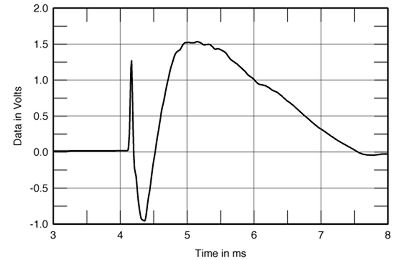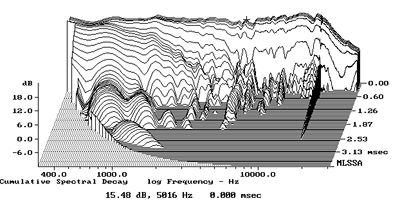| Columns Retired Columns & Blogs |
Dynaudio Confidence C4 loudspeaker Measurements
Sidebar 3: Measurements
The Dynaudio C4's voltage sensitivity was to specification, at 90dB(B)/2.83V/m. However, as the speaker's impedance magnitude (fig.1, solid trace) drops significantly below 8 ohms for three octaves in the lower-frequency range, where music has a considerable proportion of its energy, it is fair, I feel, to consider it as a 4 ohm load. The electrical phase angle (fig.1, dashed trace) is generally benign above the lower midrange, but the combination of -46 degrees and 5.1 ohms at 73Hz will rule out the use of amplifiers that are not happy with low impedances.

Fig.1 Dynaudio Confidence C4, electrical impedance (solid) and phase (dashed). (2 ohms/vertical div.)
Other than a slight discontinuity around 115Hz, which implies some sort of cabinet problem at that frequency, the impedance traces are smooth. When I investigated the cabinet's vibrational behavior with a simple accelerometer, almost all the surfaces were suitably inert. However, the back panel did feature a low-level mode at the frequency noted in the impedance plot, and the side wall vibrated between 300Hz and 350Hz in the regions above and below the black plastic styling panels (fig.2). This mode could also be detected on the front baffle adjacent to the tweeters, though the poor coupling to the air by the small region affected will work against its having an audible effect.

Fig.2 Dynaudio Confidence C4, cumulative spectral-decay plot calculated from the output of an accelerometer fastened to the cabinet's side panel level with the upper woofer. (MLS driving voltage to speaker, 7.55V; measurement bandwidth, 2kHz.)
The saddle centered on 30Hz in the impedance magnitude indicates the tuning of the rear-facing ports. I did examine the responses of both midrange units, woofers, and ports; while the outputs of the members of each pair did differ in slight detail, the outputs were similar enough that I've shown the summed results in fig.3. The output of the ports (green trace) does broadly peak at 30Hz, with a smooth rolloff above 60Hz broken by traces of energy around 120Hz and 450Hz. These are both low enough in level, however, that I hardly think they contribute to the speaker's sonic character.

Fig.3 Dynaudio Confidence C4, summed nearfield midrange responses (red trace), summed woofers (blue), summed ports (green), with their complex sum (black).
The woofers' response (fig.3, blue) has its minimum-motion point at the port tuning frequency, but rolls off very slowly above 200Hz, due to the use of a first-order crossover. The response of the twin midrange units (red) is somewhat enigmatic, as there is both broad overlap with the woofers and some unevenness in their high-pass rollout. There always exists the possibility of leakage in these nearfield measurements when the unwanted drivers can't be disconnected without surgery—when a speaker has bi- or triwiring terminals, I short-circuit the unwanted drivers for each measurement. But taken literally, this overlap means that the Confidence C4's summed low-frequency response (black trace) is exaggerated in the upper bass.
This summed low-frequency output is also shown to the left of fig.4, spliced at 300Hz to the C4's farfield response, averaged across a 30 degrees horizontal window on the lower-tweeter axis and corrected for the measuring microphone's own departure from a flat axial response. As I've explained before (see my 1998 and 1999 articles on speaker measurements in the online archives at www.Stereophile.com), this apparent upper bass will be at least partly due to the nearfield measurement technique, which assumes a hemispherical acoustic environment for the drive-units—but only partly, which correlates with what I said in my auditioning notes about the speaker's exaggerated in-room low frequencies.

Fig.4 Dynaudio Confidence C4, anechoic response on lower tweeter axis at 50", averaged across 30 degrees horizontal window and corrected for microphone response, with the complex sum of the nearfield responses plotted below 300Hz.
The Confidence's midrange output in fig.4 can be seen to be slightly laid-back, but the response in the decade between 500Hz and 5kHz is otherwise superbly flat. There is a slight lift in the octave above 6kHz, with then an earlier-than-usual top-octave rolloff, due to the fact that the relatively large-diameter tweeters start beaming lower in frequency than with sammler domes.
This can be seen in fig.5, which shows the Dynaudio's lateral dispersion, referenced to the lower-tweeter axis. The HF output starts to roll off above 10kHz even 10 degrees to the side of the main axis, and there is a slight presence-region flare apparent. However, it should be noted how evenly spaced the contour lines are in this graph, which correlates with the stable, accurate stereo imaging I mentioned in my listening notes. In the vertical plane (fig.6), the Confidence's radiation pattern is free from the severe interference effects that can afflict speakers with an asymmetrical driver array and first-order crossover filters. However, the upper midrange does shelve down if the listener sits below the lower-midrange unit, which is 36" from the floor.

Fig.5 Dynaudio Confidence C4, lateral response family at 50", normalized to response on lower tweeter axis, from back to front: differences in response 90 degrees-5 degrees off-axis, reference response, differences in response 5 degrees-90 degrees off-axis.

Fig.6 Dynaudio Confidence C4, vertical response family at 50", normalized to response on lower tweeter axis, from back to front: differences in response 20 degrees-5 degrees above axis, reference response, differences in response 5 degrees-10 degrees below axis.
Fig.7 indicates how this quasi-anechoic behavior translates in my listening room. The response trace, an average of 120 measurements taken individually for the left and right speakers and weighted toward my ear position, shows the low-frequency emphasis that I noted in my auditioning and found in the nearfield measurements, broken only by the usual lack of measured energy in the 50Hz and 63Hz bands, something that appears to be typical of my room. Lower in frequency, even though the Confidence's summed nearfield response rolls out below 50Hz, the speaker's in-room output is maintained for at least an octave lower, due to boundary effects. This speaker will clearly give a more neutral bass balance in rooms that are larger than mine.

Fig.7 Dynaudio Confidence C4, spatially averaged, 1/3-octave, freefield response in JA's listening room.
I was surprised by the energy excess in the mid-treble revealed by this graph—this was not what I heard. I can imagine only that, instead of my ears locking on to the midrange level as their reference and thus perceiving the upper-frequency balance as boosted, they were instead taking the latter as their reference (aided in this by the boosted lows) and perceiving the mids as being laid-back.
The C4's step response (fig.8) indicates that the upper-frequency drivers are all connected with positive acoustic polarity. The woofers, however, appear to be connected in inverted polarity with respect to the midrange units, which is presumably to optimize both the frequency-domain integration between the drivers and the speaker's vertical dispersion. The cumulative spectral-decay plot on the lower tweeter axis (fig.9) in general reveals superbly clean die-away, disturbed only by a residual mode at 5kHz. It's no wonder the C4's treble sounded so grain-free.—John Atkinson

Fig.8 Dynaudio Confidence C4, step response on lower tweeter axis at 50" (5ms time window, 30kHz bandwidth).

Fig.9 Dynaudio Confidence C4, cumulative spectral-decay plot at 50" (0.15ms risetime).
- Log in or register to post comments




































